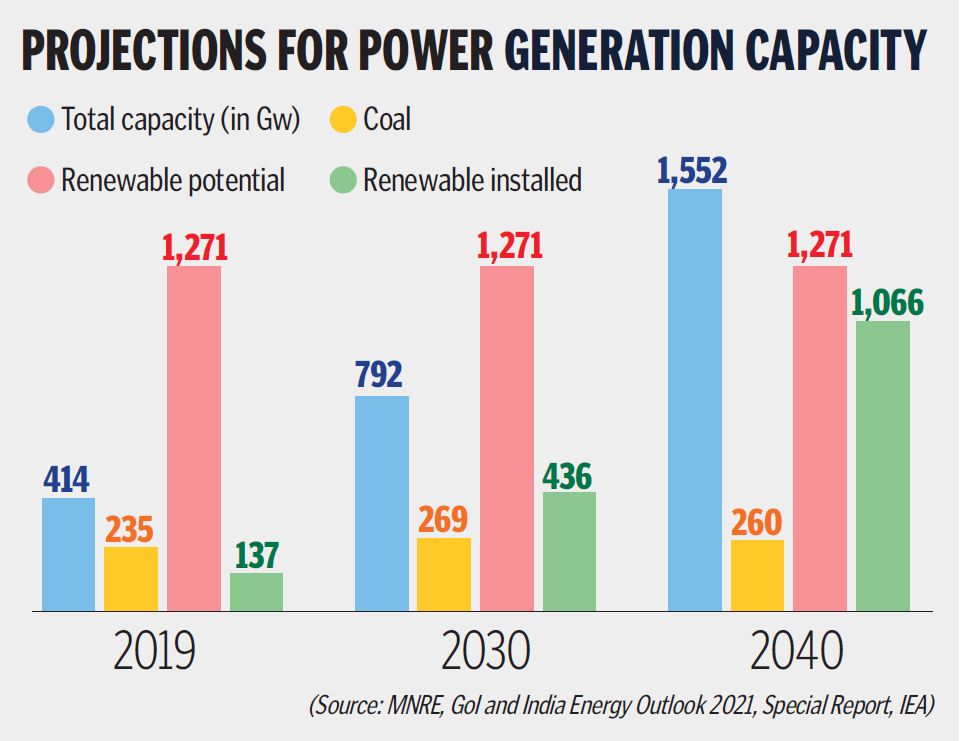Opinion: Renewables cannot replace coal
By Dr Oruganty Prasada Rao The buzzword the world over nowadays is ‘phase-out coal’. The idea is to limit the rise in global temperature to 2 degrees Celsius, preferably 1.5 degrees Celsius, compared with pre-industrial levels, as per the Paris agreement on climate change. What is wrong with coal Coal is a fossil fuel like […]

By Dr Oruganty Prasada Rao
The buzzword the world over nowadays is ‘phase-out coal’. The idea is to limit the rise in global temperature to 2 degrees Celsius, preferably 1.5 degrees Celsius, compared with pre-industrial levels, as per the Paris agreement on climate change.
What is wrong with coal
Coal is a fossil fuel like oil and natural gas. All of them contain carbon and hydrogen but in different proportions. Coal contains more carbon than hydrogen, hence it produces more carbon dioxide upon combustion as against oil and gas. In addition to carbon dioxide, coal produces ash. Because of these two main pollutants, many countries are either reducing or phasing out coal.
Phasing out coal is possible by importing oil and gas in large quantities. In 2020-21, the domestic production of crude oil and imports stood at 30.5 million tonnes and 196.5 million tonnes ($7.1 billion) respectively. In the same year, the figures for natural gas were 28,672 and 33,031 million metric standard cubic metre per day ($ 7.9 billion) respectively. The import dependence on oil and natural gas was 86.5% and 53.5% in 2020-21. Further, an increase in imports of oil and gas may not be advisable from economic and strategic points.
About 70% of coal available in the country is used for power generation and smaller percentages for the production of steel and cement. The present capacity of coal-based power plants is more than 2 lakh Mw, comprising 440 power plants generating 51% of power in the country.
Natural gas cannot be used in the existing coal plants. All of them, worth lakhs of crores of rupees, have to be scrapped to phase out coal. At present, more than half of India’s capacity to generate power from natural gas is not being utilised due to unavailability gas. Then, how can gas replace coal easily on a large scale? Power is generated from oil using diesel engines on small scale but at a very high cost and causing pollution, so oil cannot substitute coal in a big way.
Renewable Energy Scenario
Renewable energy sources comprise hydro, wind, solar, biomass, geothermal, tidal and wave.
India has a wind potential of over 300 Gw at a hub height of 100 metre, solar potential of about 750 Gw, large hydro potential of 166 Gw, small hydro potential of 20 Gw, and bio-energy potential of 25 Gw. India has about 10 Gw of geothermal energy, which is unlikely to be exploited now. There is no official estimate on the exploitable potential of tidal and wave energy in India. So, the total renewable energy potential in India comes to 1,271 Gw. India can generate 127 Gw of offshore wind energy with its 7,600-km of coastline, according to the Ministry of New and Renewable Energy. The potential will not change unless offshore wind, and tide & wave energy are exploited.
Projections for power generation capacity for the years 2030 and 2040 are shown in the infographics based on the ‘Stated policies scenario’, a balanced assessment of the direction in which India’s energy system is heading taking into account the current policies and an assumption that the spread of the pandemic is brought under control. The power generation capacity based on coal is almost the same in 2019, 2030 and 2040. The renewable potential remaining after the year 2040 is 205 (1,271 minus 1,066), which is likely to be exhausted before 2045 based on the trend of its exploitation. In that case, the same capacity of around 260 GW or more of coal-based power generation has to be maintained beyond 2040 to meet power demand, if offshore wind potential is not exploited and nuclear power is not increased which is doubtful due to safety reasons and resistance from people, or new energy sources like hydrogen are not utilised in a big way for power generation.
Green Emissions
Though renewable energy utilisation, except biomass, does not produce emissions directly, it produces indirectly during the manufacture of equipment and its transportation to site and erection. Power generation from solar and wind is intermittent and hence requires battery storage in large capacity and conversion to alternating current for feeding to the grid, which is an additional investment.
Renewable sources can substitute coal for only power generation, and not for other uses such as steel production, cement manufacture. Projections show that coal-based power generation in 2040 to be more than in 2019. The potential of renewable energy remaining at the end of 2040 would be about 205 Gw and based on the trend, the full potential would be exploited by about 2045. The offshore potential of 127 Gw could extend renewable energy utilisation by a year or two. So, more likely India will have to depend on fossil fuels, particularly coal, even beyond 2050.

Natural Gas, Oil
The capacity of natural gas-based power generation in 2019 was 28 Gw, which is projected to increase to 30 Gw and 46 Gw in 2030 and 2040 respectively. The projected capacity based on oil is insignificant – in the range of 5 Gw to 8 Gw. Hence, oil and gas cannot contribute much to phasing out coal.
Hydrogen
Hydrogen is another fuel that does not cause global warming since it does not emit carbon dioxide during utilisation. Hydrogen is at present used in transportation through fuel cells, not for power generation. The same trend is likely to continue beyond 2040. The problem with hydrogen is the way it is produced. If it is produced from coal or natural gas, the processes emit carbon dioxide. To avoid it, hydrogen has to be produced from water through electrolysis from power generated through renewable energy sources, except biomass. Water is a scarce commodity and cannot be used for hydrogen production. The solution for it is to produce hydrogen from seawater but the commercial process is not yet available. Hence, hydrogen cannot phase out coal.
Even if India wants to increase the use of renewable sources, the potential might get exhausted before 2040-45. Thus, it may be a myth to expect that renewable energy sources can substitute coal or other fossil fuels, and meet the energy requirements of India in foreseeable future.

(The author is a Retired Scientist, CSIR)
Now you can get handpicked stories from Telangana Today on Telegram everyday. Click the link to subscribe.
Click to follow Telangana Today Facebook page and Twitter .
Related News
-
EPFO offers six-month window to enrol left-out workers under EES-2025
5 mins ago -
Sameera Reddy highlights natural banana ripening, food safety
10 mins ago -
Goa nightclub fire: Co-owner Ajay Gupta moves court for bail
26 mins ago -
Police fire in air during Sarpanch poll clash in Jagtial
37 mins ago -
SC adjourns till January Baghel’s son plea against arrest in liquor scam case
1 hour ago -
Op Sindoor showed India’s swift, high-impact air power: Rajnath Singh
43 mins ago -
21st century India takes big, swift decisions and delivers results on time: PM Modi
2 hours ago -
One nation, one policy, major overhaul for organ donation
2 hours ago

